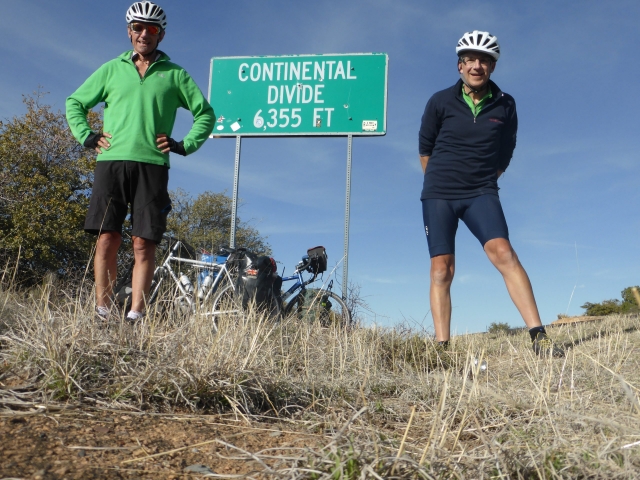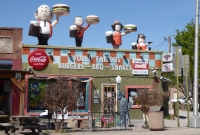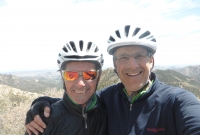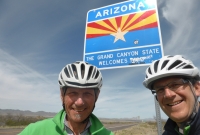If you’ve ever seen the John Wayne movie ‘Stagecoach’ then you’ll know that the film follows a group of nine strangers riding a stagecoach across Apache country to Lordsburg, New Mexico. Along the way the travellers battle Geronimo and his warriors, as well squabble and fight among themselves. The strapline for the movie reads: ‘A Powerful Story of 9 Strange People’.
Today we give you ‘A Powerful Story of 2 Strange People’ who battled their way to Lordsburg on two bicycles and fought an ever present enemy who chased and attacked them all the way to town. Not Apaches of course, but the relentless power of Mother Nature herself.
For today we shouted at the wind, we yelled at the wind and we swore at the wind – a lot. But nothing made any difference. It even made Terry lose his smile and it seemed determined to blast us straight in the face all the way from our campsite at San Lorenzo to virtually the moment we arrived in Lordsburg.

In fact the only relief we got all day was sitting down to breakfast back at the Restaurant del Sol. We’d both been so efficient in packing up our tents and breaking camp we were ready half an hour before the diner was open, so we ended up huddling in the men’s toilets at Mountain Spirits to keep warm before setting off. Fortunately we were also too early to attract any odd looks!
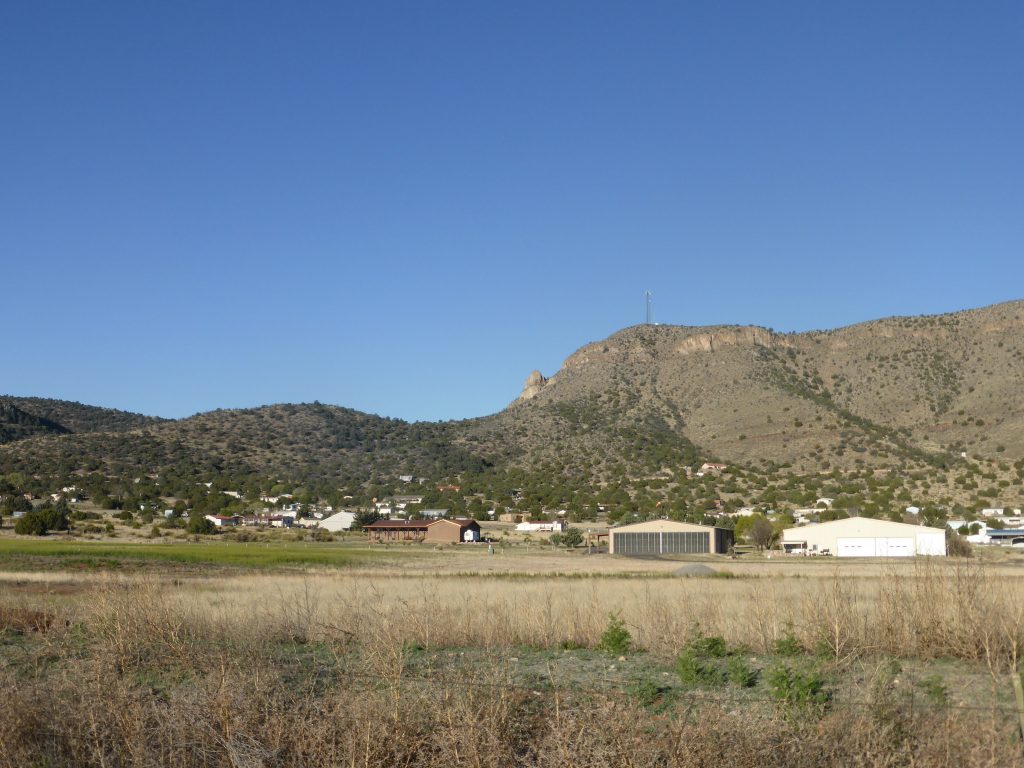
The ACA maps offer two different routes from San Lorenzo to Silver City. The more direct one takes you through Hanover and straight to Silver City, a journey of around 23 miles. Or you can take the alternate route north up to the Gila Wilderness and the Gila Cliff Dwellings National Monument.
The Gila River site with its seven natural caves was occupied as early as 100 A.D. but sometime in the 13th Century the Mogollon people utilised some of the caves to house pueblos containing around 40 rooms. The walls of their homes were constructed of stone quarried at the site.
“Today the Gila Cliff Dwellings are preserved in the Gila National Forest as part of the State’s first wilderness area, created in 1924”.
No more than 10 to 15 extended families lived at the site for any one time and its believed the cave dwellings were not inhabited for more than a century before the Mogollon moved on. Today the Gila Cliff Dwellings are preserved in the Gila National Forest as part of the United State’s first wilderness area, which was created in 1924.
We had really hoped we’d be able to include the alternate route, but it adds 92 miles to the journey – two days giving time to look around – and it just wasn’t feasible on our tight schedule. Instead we hoped to take time off a little later in the ride to explore another archaeolgical treasure trove – the ruins of the Besh-Ba-Gowah pueblo near Globe in Arizona.
So with a big ride ahead we loaded up on full breakfasts backed up by double stacks of pancakes – no point skimping on the carbs when you need power in your legs.

Eventually, we left San Lorenzo gone 9am and as the morning sun gained strength we headed up and over and out of the Mimbres River valley. Within a few minutes of setting out we hit the headwind as it funnelled through a cutting in the hills. At this time of the day it was peaking at around 15mph – by the afternoon it would have ramped up with strong gusts hitting 25mph.
It was also icy cold … and strong. Instantly reducing us to a walking pace, we had plenty of time to have a close up look at the local geology in the cutting’s walls! With the heat of the sun on your back and this blast of cold air hitting you from the front it made for difficult and uncomfortable cycling. It didn’t help that our blood supply was trying to cope with the mutually exclusive demands of our legs and lungs whilst sorting out our recent hearty fried breakfast.
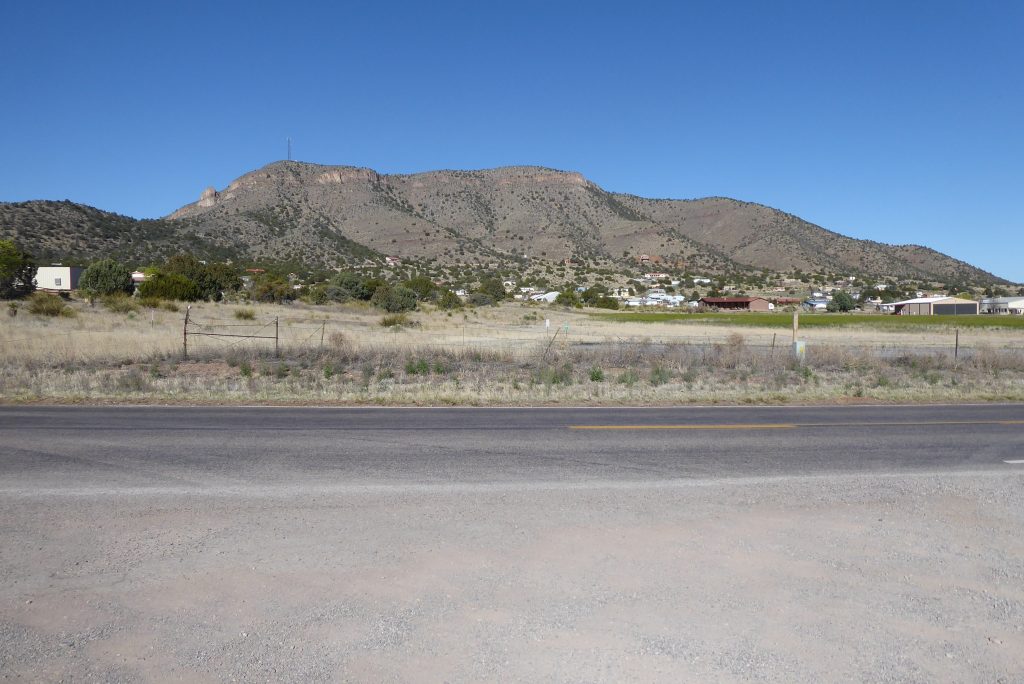
It made the climb up to Hanover far harder than it should have been, but it was certainly one way of warming up, plus the fact that despite the cold we were riding in glorious sunshine. Such was the state of the weather today that we seemed to be constantly pulling layers on and off all day long.
The Black Range mountains, which we’d hoped were a single spine, were as their name suggests, a complete range … about eight miles deep. As we struggled up amongst them we got hit by one particular gust of wind that took Terry to 2.8mph … a new low and one that seemingly defied the law of physics. This was already harder than yesterday’s 16 mile climb as the wind just kept on coming at us, especially through the cuttings, which ironically were meant to make the journey easier.
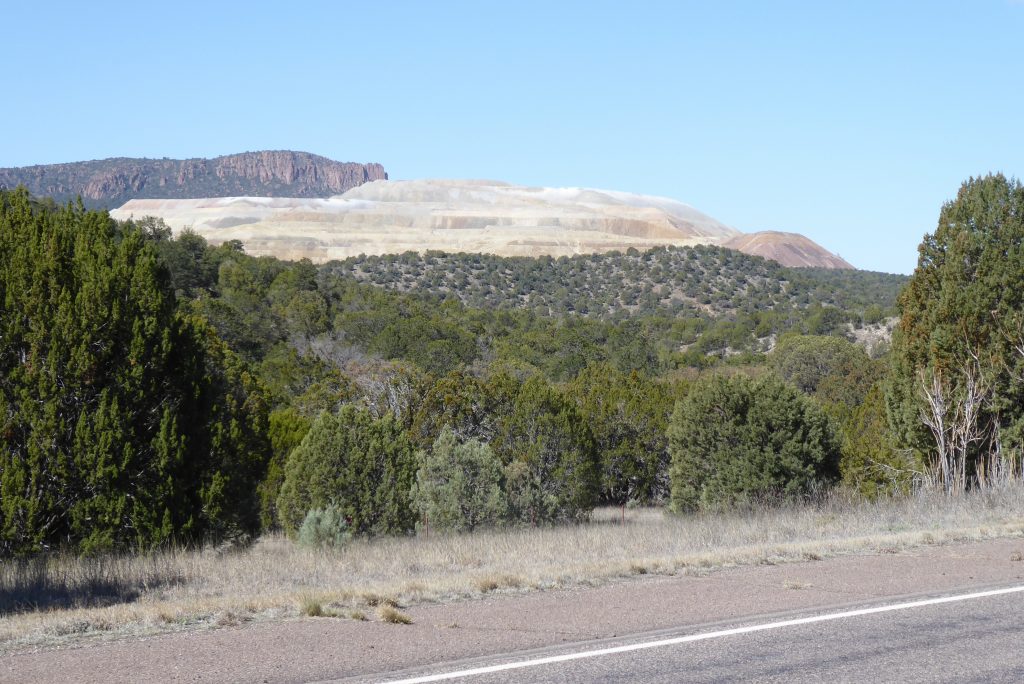
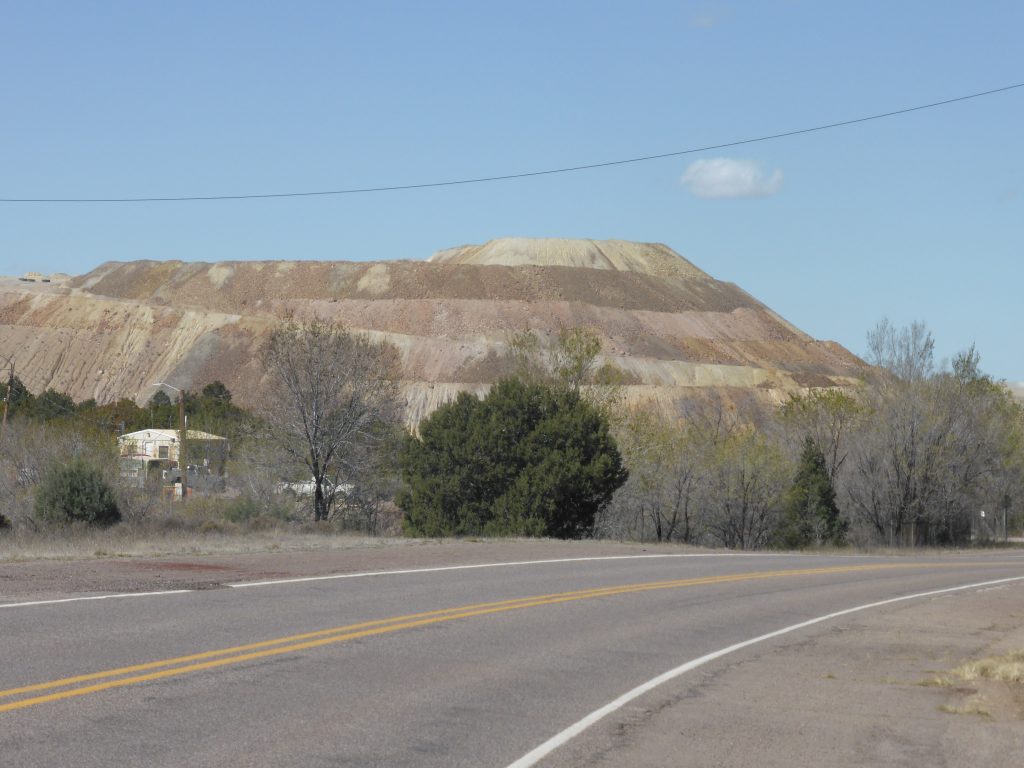
The world’s largest open copper mine, the Santa Rita Pit Mine, also known as the Chino Mine, transformed the landscape from green, sharp, uneven peaks to a flat-top, bare, pale, spoil heap that went on for miles. Getting past the spoil, the actual pit mine came into view. The scale of it was staggering … it looked like a semi-circular Roman amphitheatre … but built for giants.
Each of the 20 odd levels going down must have been at least 10m high, judging by the size of the lorries in there which themselves were enormous but looked like tiny ants compared to the vast scale of the mine.

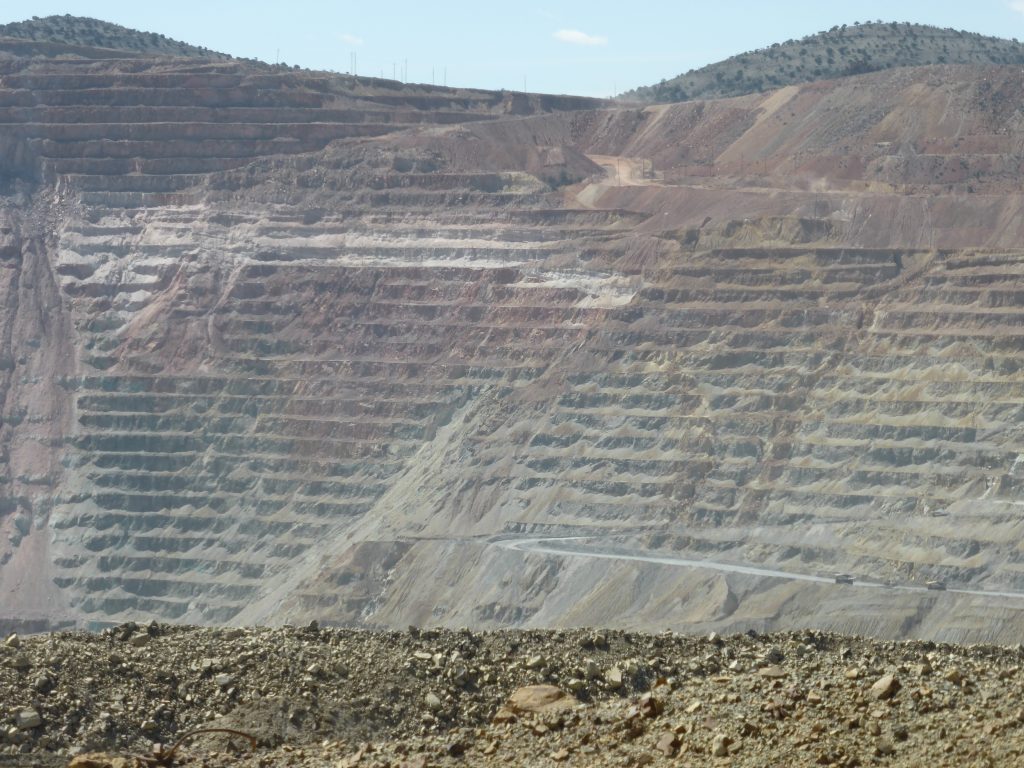

Copper was first ‘discovered’ here in 1800 by an officer in the Spanish army. The word ‘discovered’ is used very loosely of course since it refers to the first time a European had seen it, after being shown the site by an Apache.
“The scale of the operation was incredible, entire mountains reduced to shadows of their former selves”.
The Native American must have instantly regretted being so helpful because consequently the early days of the mine were marked by numerous Apache raids which didn’t cease until 1886 when Geronimo surrendered. The town of Santa Rita itself became a victim of the mine’s success, having to move several times as the pit grew and eventually abandoned in 1967.
The scale of the operation was incredible, entire mountains reduced to shadows of their former selves with the copper ore transported to a huge smelter seven miles to the south in Hurley.
Terry and I started on the beginnings of an environmental rant about the destruction of the countryside, before remembering that, just like everyone else in the modern world, we rely on the conductive power of copper for our electrics, mobile phones and no doubt plenty more essentials in our lives. And this is the cost.

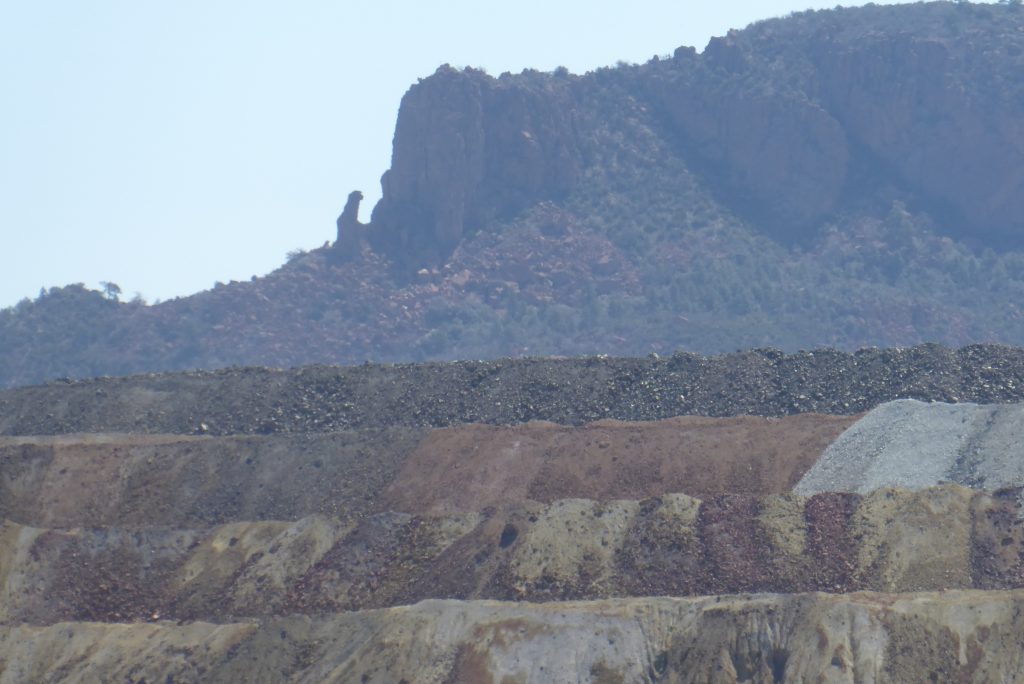
One of the mountains in the area not denuded by the mining sports a giant monolith which rests near the summit of the Santa Rita Range. It’s called the Kneeling Nun due to its resemblance to a nun kneeling in prayer before a giant altar. Perhaps these days she is praying that the diggers and blasters don’t get too close to her exposed position and send her on a journey to the smelter.
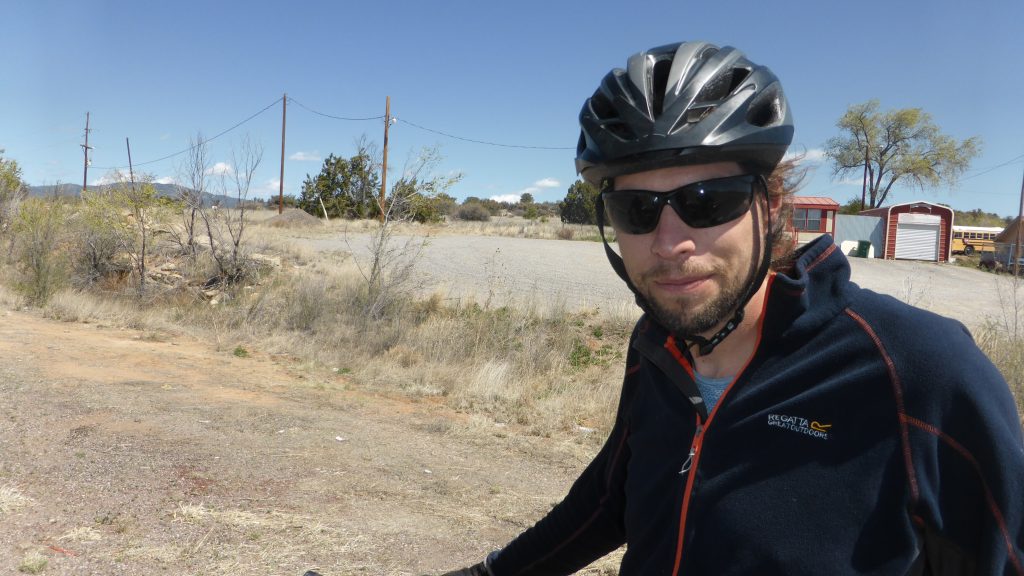
After twenty or so miles of slogging against the headwind we met Alex, who lives in south west London and riding the Southern Tier west to east. Mainly camping on route, he’d met few cyclists and was keen to stop and chat to swop stories of the road ahead. The brick wall that was doing its best to stop us moving forward was a wonderful tailwind for Alex and we looked on enviously as he was propelled east, while we continued the battle westwards.
Headwinds are so much harder on a bike than climbing. With a climb, once you reach the top you’ll be rewarded with a descent, but a headwind is just relentless. It’s also impossible to escape the monotony by listening to music or a podcast – it’s so noisy whistling past your ears that you wouldn’t be able to hear anything. All you can do is keep pushing on, try to keep in a straight line and curse incessantly under your breath.

Silver City is described as a ‘gem’ in Southwest New Mexico with ‘forest recreation, a vibrant historic downtown, art community and dozens of festivals and events’. Sadly we were pedalling so hard to get anywhere we missed the sign to the historic downtown district and ended up in a food mart grabbing a coffee and picking up a few essentials before ploughing on.
“It was already gone 1.30pm and we had to do more than 65 miles today. I was beginning to doubt we would make it”.
It had taken us more than three hours to do just 23.6 miles – an average speed of 7.6mph. This was worrying as it was already gone 1.30pm and we had to do more than 65 miles today. I was beginning to doubt we would make it.
At around 35 miles we stopped by the side of the road for a picnic lunch of bagels, with ham and cheese and crisps and a welcome break from the wind. We were having to breach a 45 mile stretch from Silver City to Lordsburg with no services so were rationing our water consumption. Fortunately the day stayed cool – if the temperatures had returned to the mid 80s it would have been unbearable.
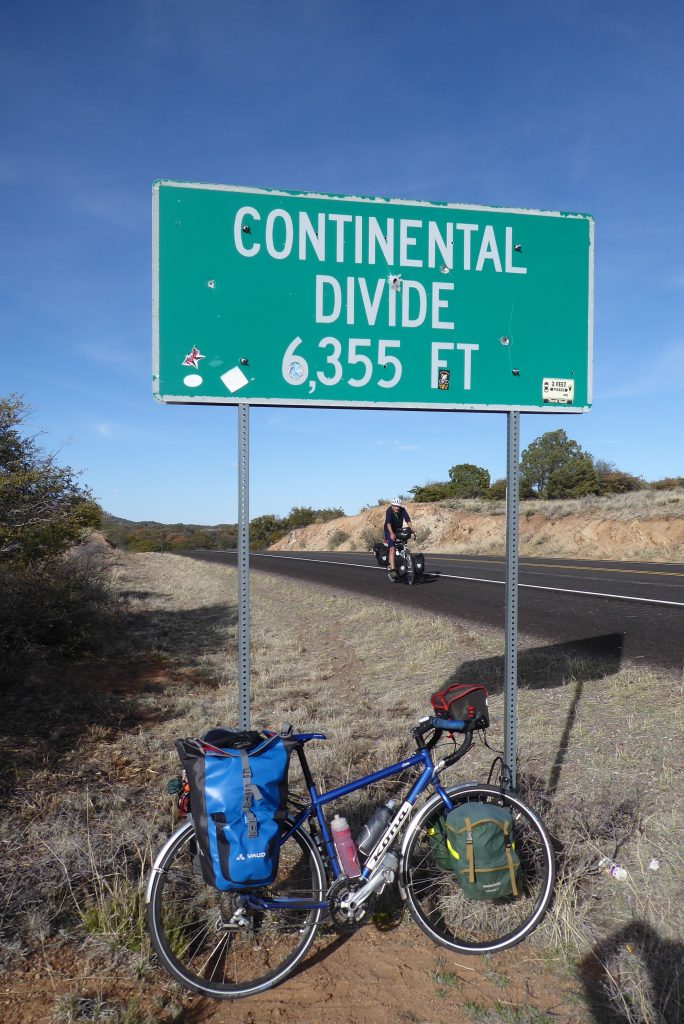
Just after White Signal we crossed the Continental Divide at 6355ft. From here on any rain that fell on us would drain west towards the Pacific, rather than east. Fortunately, unlike on the TransAmerica Trail, we only had to cross it once rather than nine times. Unfortunately the wind showed it no respect and blew on. We attempted to take some selfie photos, which all looked rather odd and then headed onwards.
Climb followed climb, descent followed descent. The wind blew on. At one point during the afternoon Terry’s speed fell again to below 3mph. On a bike that means 10 miles would take more than three hours. Entire schedules go to pot. Well intended plans are ripped to shreds.
Those glacial speeds also give you an awful long time to think and soon your mind starts playing tricks with you. Although my legs were still turning fine, with only the occasional ache, my brain was beginning to question the sanity of what I was doing. “This is ridiculous,” it complained. “At this rate it will take you another eight hours to get there – why don’t you just stop and give up?”
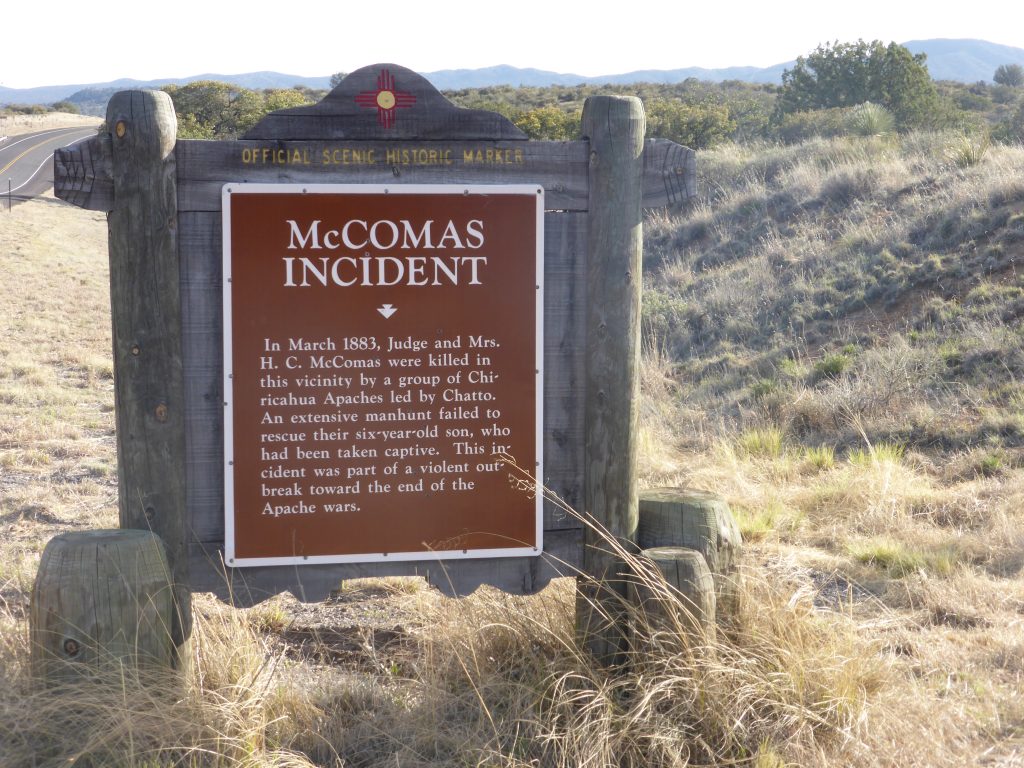
There were times I was solely tempted to stop. But what would have been the point? What would have happened then – would I have given up the ride entirely? Would I have accepted a lift if a pick-up had pulled over and offered us one?
Terry and I were obviouly thinking alike. He told me that he’d been thinking some very unpleasant thoughts about the wind when I screamed the exact words he was thinking: “Fucking wind! Give us a fucking break!!” Of course all the wind did was take our words and spat them back down the road twenty miles behind us.
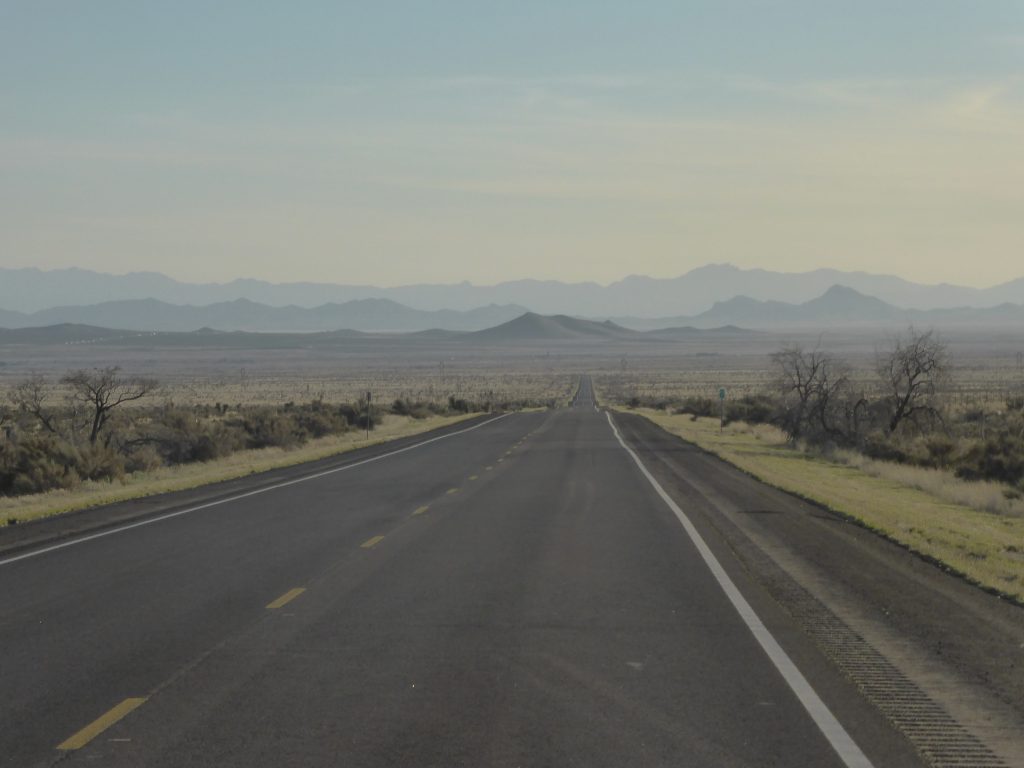
It was one of those days that makes you ask why anyone would ride a bike – and then – just as you are about to vow never to take to two wheels again, the climbing ends and the trail tips you out of the mountains, down a long descent and onto an open plain so vast and so wide the scale of the landscape just takes your breath away. And all the time the soft light of the coming dusk, the golden hour, lights the scene so perfectly you can’t imagine anywhere you’d rather be than sitting on your saddle.
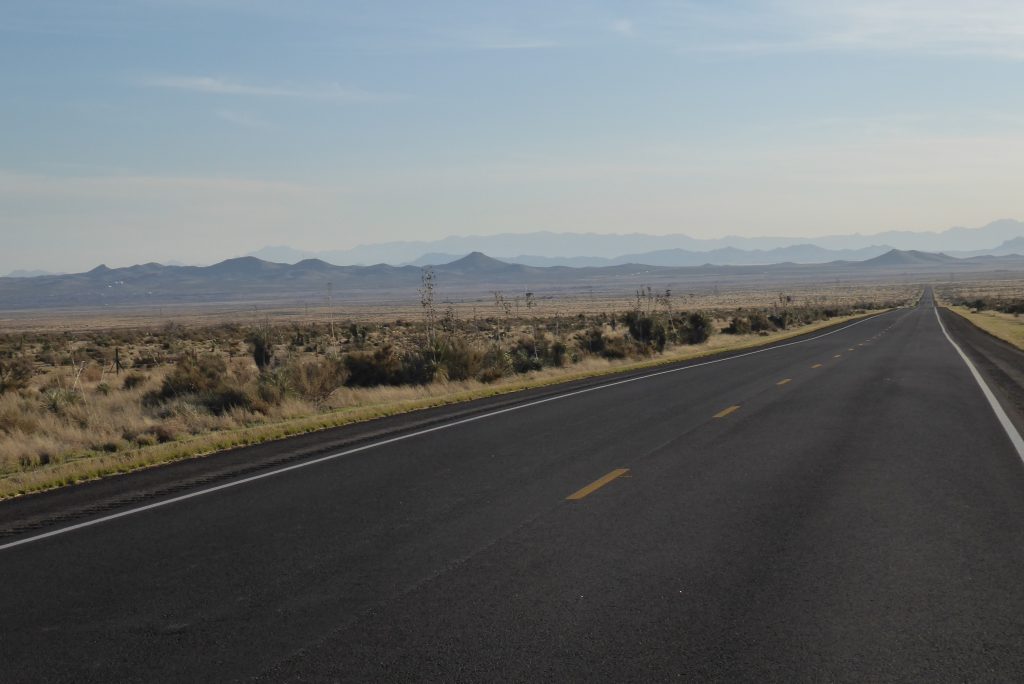
The valley stretched as far as we could see both left and right and ahead, on the horizon, were the Chiricahua Mountains of southeastern Arizona with Chiricahua Peak and Silver Peak taking the honours for their prominent summits. Nestling before them – and barely visible – was Lordsburg.

Gliding along on the silky smooth tarmac I found myself instantly elated, the relentless toil of the day completely forgotten. “This is why we do what we do!” I yelled as I caught up with Terry and captured the moment on the Go Pro. These massive awe inspiring views are what drives you to undertake a ride like this. The Southern Tier hasn’t delivered them nearly as much as the TransAm, but this wasn’t at all bad.
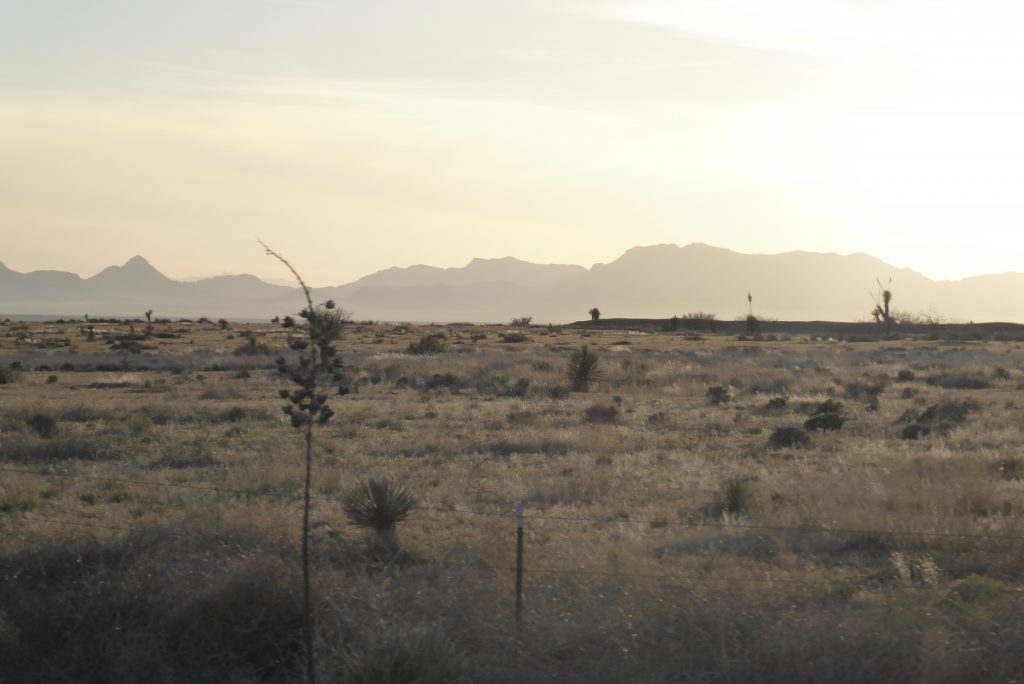
We eventually pulled into Lordsburg at 7.35pm, but by that time we didn’t care anymore. The half hour ride across the open plain, spotting wild deer and watching the sun go down had more than made up for it.
When John Wayne’s character, the Ringo Kid, finally arrived in Lordsburg he guns down the three Plummer brothers who killed his father and brother and then disappears over the Mexican border with Dallas, a local prostitute, he has fallen for.
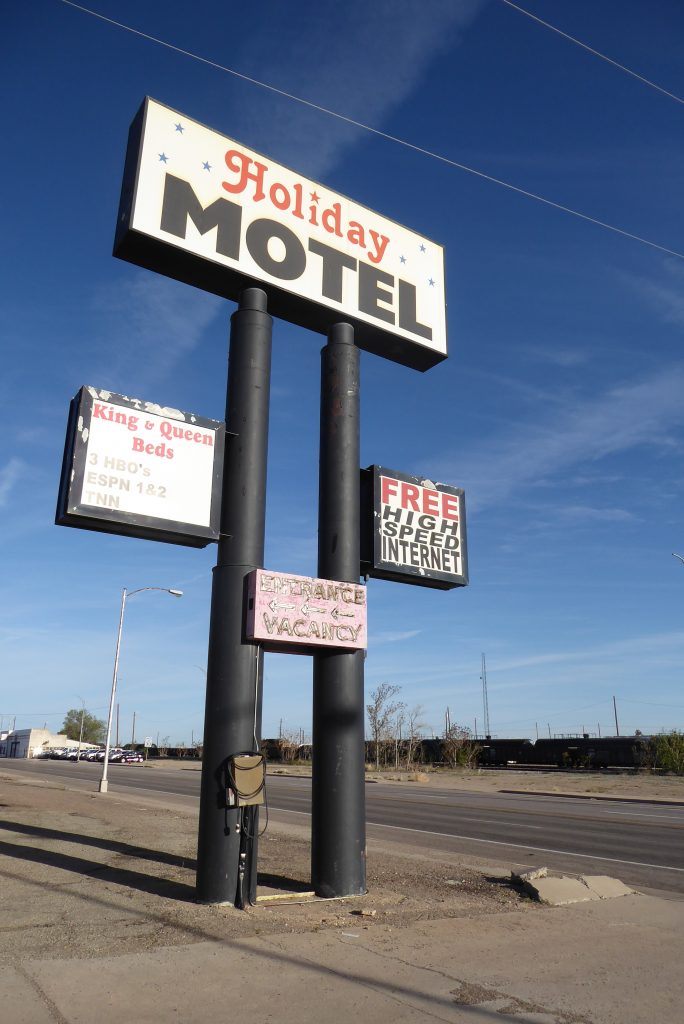
Our arrival was far less dramatic, but that suited us fine. After picking up supplies at the Family Dollar we checked into the rather low rent Holiday Motel, complete with derelict swimming pool and celebrated our safe arrival with microwave dinners, tins of fruit and microwaveable broccoli and sprouts, which were completely tasteless and would return to haunt us the following day.
Tomorrow – wind or not – natural or self generated – we have 70 plus miles to do:
Blow, winds, and crack your cheeks! rage! blow!
You cataracts and hurricanoes, spout
Till you have drench’d our steeples, drown’d the cocks!
You sulphurous and thought-executing fires,
Vaunt-couriers to oak-cleaving thunderbolts,
Singe my white head! And thou, all-shaking thunder,
Smite flat the thick rotundity o’ the world!
Crack nature’s moulds, an germens spill at once,
That make ingrateful man!
Today’s miles: 68.92
Total miles since Anastasia State Park: 2,320.76

